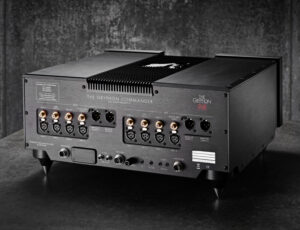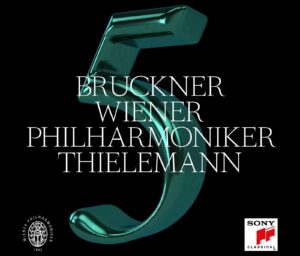
In the film Caddyshack, the character Ty Webb (played by Chevy Chase) is an affable businessman and crack golfer who even plays well when blindfolded. At one point, he undertakes to give some free advice to the ambitious teenage caddy named Danny (Michael O’Keefe). As the duo survey the course at the venerable Bushwood Country Club, Webb recites a saying that he fancifully attributes to the famous 17th-century Japanese philosopher and haiku poet Matsuo Basho: “A flute with no holes in it is not a flute. A donut with no hole is a Danish.”
So, what does that make the Danish Gryphon Commander—a black aluminum two-chassis design with no external knobs or switches that essentially does almost nothing to the audio signal? I’m no philosopher, but I can attest that it makes the Commander not just a preamplifier but something of a magical instrument.
Your eyes will tell you a lot of the story. Put bluntly, the Gryphon Commander preamplifier is a commanding object. Its separate boxes are connected by three cables, which are the only slender thing about it. The hefty power supply sits silently, whether in operation or not. So does the signal-processing chassis. No noise, no vibration, no nothing. Just obsidian silence. Quite a feat for a large power supply that contains four custom-made 36VA toroidal transformers, two for each left and right channel, that go a long way toward rendering this preamp as potent as a lot of amplifiers. The power supply is also capable of powering a forthcoming phono- stage from Gryphon as well as a digital source. A substantial remote control with a rubber pad on the back to avoid scratching furniture controls the Commander, unless you decide to use your fingers and employ the 4.3″ TFT capacitive touchscreen.
Situating the Commander in my custom HR-X stand required two people to ensure that the preamp didn’t get dented or scratched or take a chunk out of the stand itself. Fortunately, Jeff Fox of Command Performance AV in Falls Church, Virginia, and Anthony Chiarella, the Director of Sales and Marketing for Gryphon North America, were both on hand to help install it safely. All the fuss proved to be worth the effort. The Commander, which is the successor to the company’s earlier Pandora preamplifier, did not open up an auditory Pandora’s box. Instead, it offered a reminder of the importance of great power exercised with responsibility.

In the past few years, I’ve listened to a variety of excellent preamps, including the Boulder 3010 and the Ypsilon PST-100, Mk. II. My current reference is the Swiss battery-powered darTZeel NHB-18NS, which includes a phonostage. The Commander brought its own unique blend of attributes to the sonic table. I didn’t only enjoy listening to it; I reveled in its dynamic prowess and its ability to resolve fine details, both of which can be traced to its superlatively low noise floor. Throughout my audition, the Commander did as little to alter the signal emanating from digital or analog sources as I’ve ever heard a preamp do. It would be hard to think of a more linear and immaculate component.
It may sound paradoxical, but the quiescence of the Commander was immediately audible. It provided silky black backgrounds on recording after recording. One CD that I very much enjoyed listening to on the Commander, for instance, was a live recording from December 2010 of the legendary Chicago Symphony Orchestra brass section playing everything from Bach to Percy Grainger, from Gabrielli to Prokofiev. All the power on tap meant that the Commander was able to situate each instrument securely in its own space. This was particularly noteworthy, as it were, on a spooky piece by the Mexican composer Silvestre Revueltas called “Sensemaya.” The tuba emerged from what seemed like prehistoric depths with an almost voluptuous tone, conveying well the instrumental rendering of the Cuban poet Nicolas Guillen’s saga about a ritual Afro-Caribbean chant that is recited during the killing of a snake. And drumsticks had a more authoritative and realistic crack to them. Then there was the CSO brass’ rendition of Bach’s C minor Passacaglia and Fugue which vividly displays the clarion might of the ensemble. The precision of soundstaging on Bach’s blockbuster work was truly marvelous, and the piccolo trumpets had a piping quality to them that was wholly endearing.
Another thing all the power of the Gryphon buys you is effortless relaxation—not the soggy kind that you find when collapsing into a La-Z-Boy, but something much tauter and more elegant. The sheer exactitude of the Commander meant that there was no sense of smearing or bloat, which translated into an enviable clarity of musical line. This attribute was abundantly apparent when I streamed Roberta Flack, who made an abortive attempt at a career as an opera singer then took R&B to new heights, singing “Jesse” or “I’m the Girl” on her classic album Killing Me Softly. The Commander’s lack of grain and its iron-fisted control allowed it to highlight the lilting and lissome quality of her voice. Something similar occurred on a Concord LP of the Warren Vache Trio called Midtown Jazz. The elegant breathiness of Vache’s cornet playing on numbers such as “I’m Old Fashioned” was never more in evidence on my stereo system. On Count Basie Remembered [Nagel Heyer Records], which features the New York All Stars playing live in Hamburg, Germany, everything snapped into place. When a preamp exerts the kind of grip that the Commander does, it becomes a lot easier to trace the interplay of an ensemble, as well as its flow. The rhythm becomes audibly snappier on swing music, as the instruments, from piano to guitar, seem to stop and start just a hair more quickly. The command of the Commander provides that “you are there” sensation that all audiophiles in good standing tend to covet.
The might of the Commander also means that it can distill the music to its essence, stripping away any electronic detritus or encrustation. This came home to me while listening to the famous German soprano Elisabeth Schwarzkopf. She made many recordings under the supervision of her husband, Walter Legge, who headed the classical music division at EMI/Angel. One such LP was a 1975 release on the EMI label called Songs I Love that I recently picked up off eBay. Its superb quality directly reflects the notoriously authoritarian Legge’s fastidious attention to detail (he was known, among other things, as “the autocrat of the turntable”). Two notable songs on this recording are Schubert’s “To Silvia” and “Still Sea.” In her insightful memoir of Legge, On and Off the Record, Schwarzkopf observes, “Schubert did not soak himself in his poets; his nature was so full of music, so rich in melody, that almost any piece of verse was enough to stimulate his imagination.” Still, it almost goes without saying that these two songs, which set to music poems by Shakespeare and Goethe, traverse the highest artistic peaks, whatever Schubert’s inattention to poetry. In listening to them through the Commander, I heard an unprecedented level of clarity on the vocal lines and in the relationship between voice and piano that made it simplicity itself to follow both the text and Schwarzkopf’s musical intention. In this regard, it reminded me of the mesmerizing transparency that I experienced when recently visiting my friend Ali Saad’s elaborate Avantgarde Trio setup in Beverly Hills.
More Schubert was on tap when I reached for the Austrian baritone Florian Boesch’s 2012 recording of the Viennese composer on the Hyperion label. As you would expect, Hyperion did a bang-up job, but the Commander took it to a new level in terms of pellucid playback. It would be easy to confuse the calm that the Commander conveys with placidity. But that’s really not the case at all. Rather, the reserve power means that the most delicate tonal shadings at pianissimo levels—those umbratile passages that can be so haunting in classical music—are conveyed with stupendous fidelity on songs such as “Der Wanderer.” My attention did not wander. On the contrary, on numerous recordings I was impressed by the Commander’s ability to capture the tonal shadings of a variety of singers.
As you would expect, the brute force of the Commander also means that it exerts a degree of control in the bass that is quite rare. On jazz recordings, where the recording of the standup bass can often be a little murky, the Commander reached right down into the nether regions to clear matters up. And on numbers where you just rock out—Pharrell Williams’ Girl or Isaac Hayes’ Shaft—the Commander, in tandem with darTZeel 468 amplifier, provided a bass foundation that was both richly sonorous and rock solid. On Williams’ hit song “Happy,” the cymbal in the background could hardly be crisper. What’s more, there was simply no sense of bass bloat on numbers such as “Gush,” where Williams evocatively croons about “wanting to get dirty, girl.” Suffice it to say that the performance of the Commander is always pristine.
Perhaps the best way to describe the Commander is as a preservation device. It preserves the signal about as well as a Boulder preamp but adds a degree of silkiness to the proceedings. And it’s got real cojones. If you’re the kind of person that wants to go straight to the source, as my colleague Jonathan Valin likes to say, then the Commander really should be at your beck and call. Compared to the darTZeel preamp the Gryphon lacks a bit of the supernatural musical flow and midrange bloom that is the hallmark of that preamplifier. But the Commander has superior dynamics, a lower noise floor, better control of the bass, and more accurate transient pitch definition. The Commander occupies a spot at the very apex of musical playback and casts an enchanting spell, whether or not you happen to be a devotee of the fabled Basho.
Specs & Pricing
Inputs: Four pairs XLR balanced, two pairs RCA single-ended
Outputs: Two pairs XLR balanced, one pair RCA single-ended
Input impedance: 18k ohms balanced, 12k ohms single-ended
Gain: 18dB
Frequency response: 0.1Hz–1.5MHz at –3dB
Dimensions: Audio/control unit, 18.8″ x 9.3″ x 17.9″; power supply, 18.8″ x 9.29″ x 17.3″
Weight: Audio control unit, 67.2 lbs; power supply, 84.2 lbs.
Price: $63,000
GRYPHON AUDIO NA Inc.
9 Lynn Court, Woodcliff Lake, NJ 07677, USA
Anthony Chiarella, Director of Sales & Marketing
(201) 690-9006 (office)
(201) 264-7217 (cell)
anthony@gryphon-audio.dk

By Jacob Heilbrunn
The trumpet has influenced my approach to high-end audio. Like not a few audiophiles, I want it all—coherence, definition, transparency, dynamics, and fine detail.
More articles from this editor





















